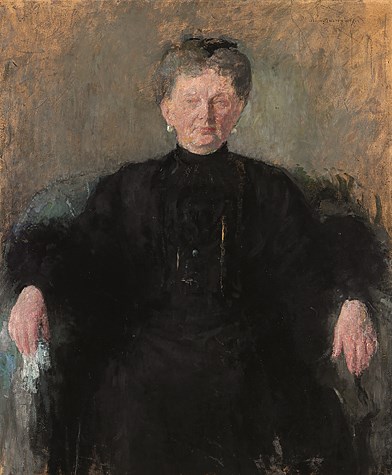Description:
Olga Boznańska’s (1865-1940) education began with private drawing lessons, followed by attending the Baraniecki Women’s Courses in Krakow. As a woman, she could not be a student at the Academy. An important step in her education was her stay in Munich and visits to European museums, where she was amazed by Velázquez, Monet and Whistler. Her goal was Paris, and it was there that she settled and set up a studio after achieving her first successes at exhibitions throughout Europe. She painted landscapes, still lifes, interior scenes and moody portraits, for which she became famous.
Description of the painting:
Countess Róża Raczyńska arrived at the studio of the renowned, fashionable Polish portraitist Olga Boznańska in 1912. The countess’s sternness intimidated Boznańska, and a certain distance between the artist and the person being painted is visible in the piece. We see an older, grey-haired woman, swathed in black, her face lined with wrinkles, her gaze somewhat absent and bright. She sits quite freely, yet imperiously. Boznańska typically focused on the face and hands of her models, not seeking to prettify her subject but instead to capture their character.
The turn of the nineteenth and twentieth centuries saw a great development of painting in Poland. Kraków was a particularly important centre of artistic life, home to the School and then the Academy of Fine Arts. During the tenure of directors such as Matejko and his successors, including Julian Fałat, the Academy produced a large number of distinguished graduates, many of whose works can be seen in the Rogaliński Gallery, including those of female artists, who were not then admitted to the Academy.
Olga Boznańska owed her first lessons in drawing and her artistic sensibility to her mother, a French governess working in Poland. She then went on to receive private tuition and attend the Ladies’ Courses of Kraków. Inspiration was also provided by visits to European museums, where Boznańska was enraptured by the works of Velázquez, Monet, and Whistler. She continued her studies at the important artistic centre of Munich, where she eventually spread her wings and opened her own studio. Paris, however, was her dream. Half French, the language and culture of the country were not alien to her. As her success in Europe and reputation as an artist grew, she moved and opened a studio in Paris, where she lived until her death.
Paris was a popular destination for aristocrats from across Europe, who visited for both social occasions and to view exhibitions, galleries, and the studios of recognised artists, in order to find works for their private collections or that fitted the current fashion. Portraits were also commissioned there. Róża Raczyńska appeared in Boznańska’s Parisian studio in 1912, at a time when the artist’s work was fully developed and she was enjoying considerable popularity. Her days were filled with creating amidst a cloud of cigarette smoke and the aroma of her beloved coffee. She was known to spend a long time painting one portrait, taking the time to get to know her model in order to capture their character and not just their appearance. It was said that her sitters aged and greyed in her studio and that only death freed them from posing. However, Róża Raczyńska did not have to wait that long. Her strong personality intimidated Boznańska and a certain distance between the person being painted and the artist is detectable in the painting.
Boznańska did not usually prettify her models, instead seeking to reveal the whole truth. She acted similarly in this case. The painting shows an older woman with grey hair and a face lined with wrinkles. Róża does not look at us; her gaze, somewhat absent, is directed elsewhere, or perhaps inwards. The dark dress dominates the painting, a large, dark, symmetrical patch in which the outlines of the dress are the only visible elements. Boznańska focused on the face and hands, which were of the most interest to her and of which the most is revealed about the character of the person being painted.
In comparison to other images or photographs of the Countess showing her holding a stiff, impeccable figure and her sharp, bright blue eyes looking straight at the viewer, this portrait appears more relaxed. Her hands rest loosely on the armrest of the chair she is sitting on. Although her face suggests a woman of great determination and experience, she allows herself to relax, to loosen up, for this brief moment. Her gaze is absent, yet piercing, and her lips form a gentle smile. Despite a certain stiffness and hieratic presentation, the Countess appears almost at ease. Her hands, instead of being clasped in her lap, rest loosely on the arm of the chair. We can imagine her taking a deep breath.
Boznańska usually painted on cardboard, which she used here too. With the dry application of paint onto the translucent, golden background, a matt effect was obtained, which the artist desired. She applied the paint with short strokes, one after the other, creating a vibration and intermingling of colours. Colour combinations were of more interest to Boznańska than form, as can be easily seen in the portrait of Róża, where shapes merge and permeate one another, as if we were looking at the Countess in the light of dusk, when everything blurs, loses its brightness, and sharpness. Boznańska was often accused of painting sad, grey works, but she herself argued that since she was not a happy person, her art should not be either.


